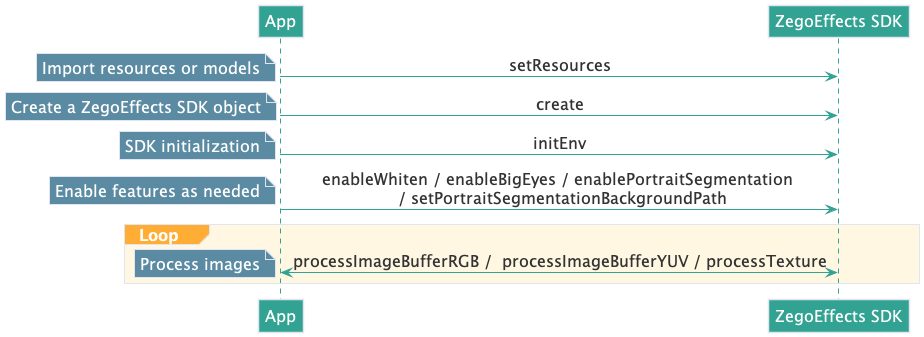- Documentation
- AI Effects
- Getting started
- Implement basic image processing
Implement basic image processing
This document describes how to implement basic image processing with the ZegoEffects SDK.
Prerequisites
Before implementing the basic image processing functionality, make sure you complete the following steps:
- Integrate the ZegoEffects SDK into your project. For more information, see Quick starts - Integration.
- Get the unique license file of the SDK. For details, see Online privilege authentication.
Implementation steps
The following diagram shows the API call sequence of basic image processing with the ZegoEffects SDK:
)
Create a ZegoEffects object
Import the AI resources and models.
To use the SDK's AI features, you must import the necessary AI resources or models by calling the
setResourcesmethod. For details, see Quick starts - Import resources and models.// Specify the absolute path of the face recognition model, which is required for various features including Face detection, eyes enlarging, and face slimming. ArrayList<String> aiModeInfos = new ArrayList<>(); aiModeInfos.add("sdcard/xxx/xxxxx/FaceDetectionModel.bundle"); aiModeInfos.add("sdcard/xxx/xxxxx/Segmentation.bundle"); // Set the list of model paths, which must be called before calling the create method. ZegoEffects.setResources(aiModeInfos);
Import the license file to create a
ZegoEffectsobject.Call the
createmethod to create an instance of theZegoEffectsclass, passing in the content of the license file as thelicenseparameter.// Create a ZegoEffects object, passing the content of the license file to the `license` parameter. String license = "xxxxxxx"; ZegoEffects mEffects = ZegoEffects.create(license, applicationContext);
Initialize the ZegoEffects object
Call the
initEnvmethod to initialize theZegoEffectsobject, passing in the width and height of the original image to be processed.// Initialize the ZegoEffects object, passing in the width and height of the original image to be processed. mEffects.initEnv(1280, 720);Call the following methods to enable the AI features you want to use.
enableWhitenenableBigEyessetPortraitSegmentationBackgroundPathenablePortraitSegmentation// 1. Enable the skin tone enhancement feature. // 2. Enable the eyes enlargeing feature. // 3. Enable the AI portrait segmentation feature, passing in the absolute path of the segmented background image. mEffects.enableWhiten(true) .enableBigEyes(true) .setPortraitSegmentationBackgroundPath("MY_BACKGROUND_PATH", ZegoEffectsScaleMode.ASPECT_FILL); .enablePortraitSegmentation(true);
Perform image processing
Call the processTexturemethod to perform image processing. SDK also supports YUV, Texture, and other formats for image processing. For details, see the following table:
| Video frame type | Pixel format / Texture ID | Method |
|---|---|---|
| Buff |
|
processImageBufferRGB |
| Buff |
|
processImageBufferYUV |
| Texture | Texture ID | processTexture |
The following sample code calls the processTexturemethod for image processing:
ZegoEffectsVideoFrameParam zegoEffectsVideoFrameParam = new ZegoEffectsVideoFrameParam();
zegoEffectsVideoFrameParam.setFormat(ZegoEffectsVideoFrameFormat.RGBA32);
zegoEffectsVideoFrameParam.setWidth(width);
zegoEffectsVideoFrameParam.setHeight(height);
// Pass in the textureID of the original video frame to be processed, and return the textureID of the processed video frame.
zegoTextureId = mEffects.processTexture(mTextureId, zegoEffectsVideoFrameParam);

